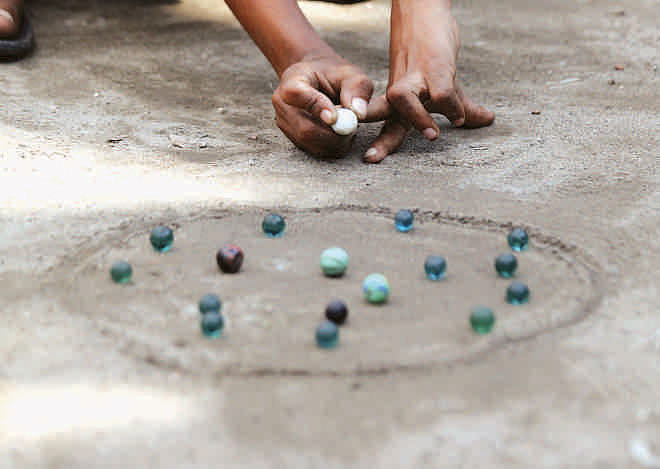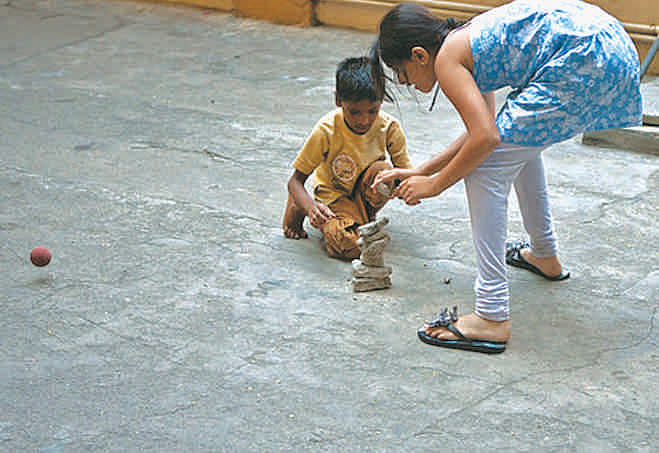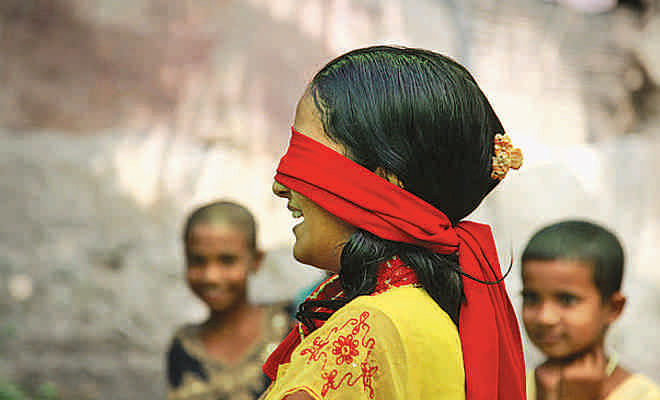PLAYTIME

Along with music, poetry and art, various games shape our culture. The sight of children enjoying these games like kanamachhi is not uncommon, particularly in the countryside. On the other hand, city skylines marked by tall and crowded buildings means we look indoors for recreation. Does this mean we will be forced to let our traditional games fade away? They don't have to. Many true blue Bangladeshi games can be played in the city. And it doesn't have to be a 'moral obligation' either. These games are fun. Try them and you'll be pleasantly surprised.

CHHOWA CHHUI
Two or more can play this game. A wall or tree or any other chosen object is known as pakka or the 'base'. Players run to this pakka and when they are in contact with it, the chor or 'chaser' cannot catch them. Then they run fast to the next chosen object. This way they run from one object/spot to another until they are caught when not in contact with the base. When the chaser catches a player, they switch roles. This game does not require very large spaces. If a few are playing, a relatively empty room or a small area in the park works fine. My friends and I used to play this in the school playground before assembly. Similar versions of the game include Borof Pani and Kumir Danga.
LATIM
A latim or lattoo (top) is a pear-shaped wooden toy with a metal pin at the bottom. This is set into motion by aid of a string, turned around the round surface of the top and released onto a hard surface to spin. Friends can play this game together and the player whose lattoo spins the longest wins. Since a hard surface is needed for the lattoo to spin, this is a perfect indoor game.
LUKOCHURI
A person is chosen and called the 'police'; he/she counts to a certain number with their eyes closed. Meanwhile the others, chor, hide themselves. It is the duty of the police to seek them out. As soon as a chor is caught, the person who catches him shouts to indicate that he has been caught and is out of the game. With cupboards, beds and tables our houses are potential lukochuri play-sites.

MARBLES
Glass balls or marbles are also known as goli. Each player has to have a goli. A small hole is dug on plain ground, often with the heel of the foot. The players position themselves about two yards away from the hole. Then they kneel down and try to send the marble into the hole. The marble is held tightly with the forefinger of the left hand. The finger is stretched back like a bow-string by the pressure of the forefinger and thumb of the right hand. When the finger is released, the goli goes forward, often overshooting the hole. Each player has to strike the goli thrown by the other players out of the way, to prevent them from gaining points. Or, with a gentle blow from one's marble, push the others, so that they drift into the hole. (If this is done the person responsible for getting the marble into the hole gets points) Whoever is the first to get all the marbles into the hole, is the winner. The game can take several hours and is challenging. Since it requires holes to be dug into the ground, it needs to be played outside. But it doesn't take up much space so an area inside the park of your residential area is perfect. Marbles are pretty cheap.
RUMAL CHOR
Rumal chor can have a large number of players. One of them is the chor (thief). The rest sit facing one another in a circle with their eyes closed for some time. Within this period the chor runs behind others and suddenly leaves his rumal (handkerchief) behind one of the sitting players. On some signal from the chor, everybody starts looking for the rumal behind them. The one who finds it runs after the chor to catch him. The chor runs around in circle and tries to not get caught. He/she also tries to take the vacant seat of the person chasing him/her. If the chor is caught by the person with the rumal, he again becomes the chor; in this way the game continues. If the chor manages to take the vacant place, the chaser becomes chor instead. More number of players is a bonus as it makes a bigger circle and allows for more running area. A large room works just fine but if it's an option and many are playing, it's a fun outdoor game.

EKKA-DOKKA
Ekka-dokka can be played by both girls and boys, but mostly girls are seen playing it. A rectangle about three yards long and two yards wide is drawn. This rectangle is divided into six squares. The fourth and the sixth squares are each subdivided into two and these are crossed diagonally from side to side.
The first player stands before the starting line and tosses a round, flat stone/ brick chip into the first square. Then he/she skips the first square, hopping to square number two and continues hopping up to square six. Then he/she turns around and hops back. He/she stops at square number two, picks up the stone, hops over square one and comes out. The game continues by the stone being tossed in square number two, and so on till the sixth square. All the hopping is done on one foot, except for those squares that are divided into two and drawn side by side. The player puts both feet down into the two squares, with one foot in each of them. The player must hop over or skip the square where the stone has been placed. You are declared 'out' if the stone fails to land in the appropriate (progressively higher) square, so the game gets more difficult with each toss. If you step on a line, or lose your balance while bending to pick up the stone, or put your other hand or foot down into the square into which the stone has been tossed, game over. Since you have to draw squares, it's a good idea to play this on a roof (but only if it has railings; and remember to stay away from the edge).
RAJA-MANTRI-CHOR-SIPAI
Chits are made for raja or king (1000 points), mantri or minister (500 points), chor or thief (0 points) and sipai or guard (100 points). Each of the four players picks one of the seemingly identical chits. The one who gets the raja chit then exclaims 'Who is my mantri?' The mantri responds, and he/she is then asked by the raja to identify the chor from the rest of the players. If the mantri guesses correctly, then he/she retains the points, if not the points are given to the chor. Each round continues like this. The player with the highest points wins in the end. It is easy and fun and can be played anywhere.

KANA MACHHI
A kanamachhi is chosen from the players. He/she is then blindfolded. The other players run around the kanamachhi. The children shout out the rhyme 'Kana machhi bho bho, jake pabi take chho'. The kanamachhi runs after the others trying to catch one of them. The person who is touched or caught has to be identified by name. If correctly identified, he/she becomes the new kanamachhi, and the game repeats. A large empty space is appropriate for this game as we don't want to injure our kanamachhi.
KABADI
Last but not least, kabadi is the national game of Bangladesh. it is played by two teams of 12 players, each on a rectangular court in which a player, while holding his breath, runs into the opponent team's area, touches some player(s) and/or wrestles out to come back home safely without releasing his breath. In doing so he/she scores point for his/her team. The team consists of 12 players but only seven play in the court and the rest are extras. While intruding into the opponents' area, the player clearly and audibly repeats the word 'kabadi' without break and without releasing the breath. The team with the more points wins. Another variant of this game is ha-du-du, but the latter is played without as many rules.
Bangladeshis being an energetic and challenge-ready bunch play many other games as well, including dariabandha, shaath-chara etc. Take a break once in a while from the busy city life and rediscover these fun traditions.

Sources: http://www.banglapedia.org/HT/K_0001.htm
http://www.maamatimanush.tv/articles.php?aid=516

 For all latest news, follow The Daily Star's Google News channel.
For all latest news, follow The Daily Star's Google News channel. 



Comments